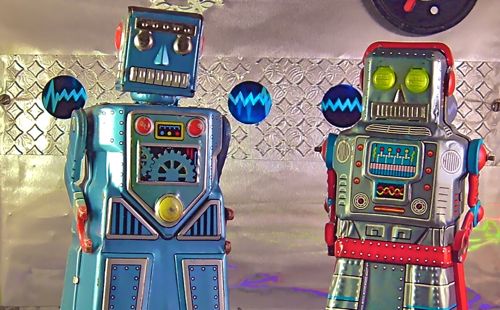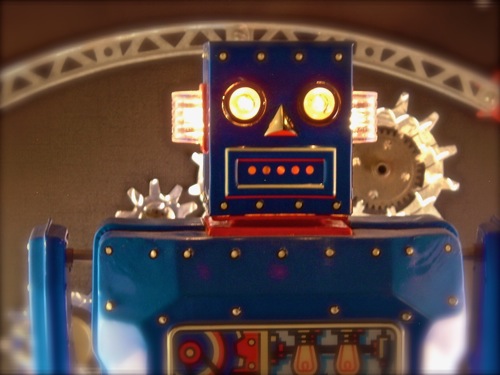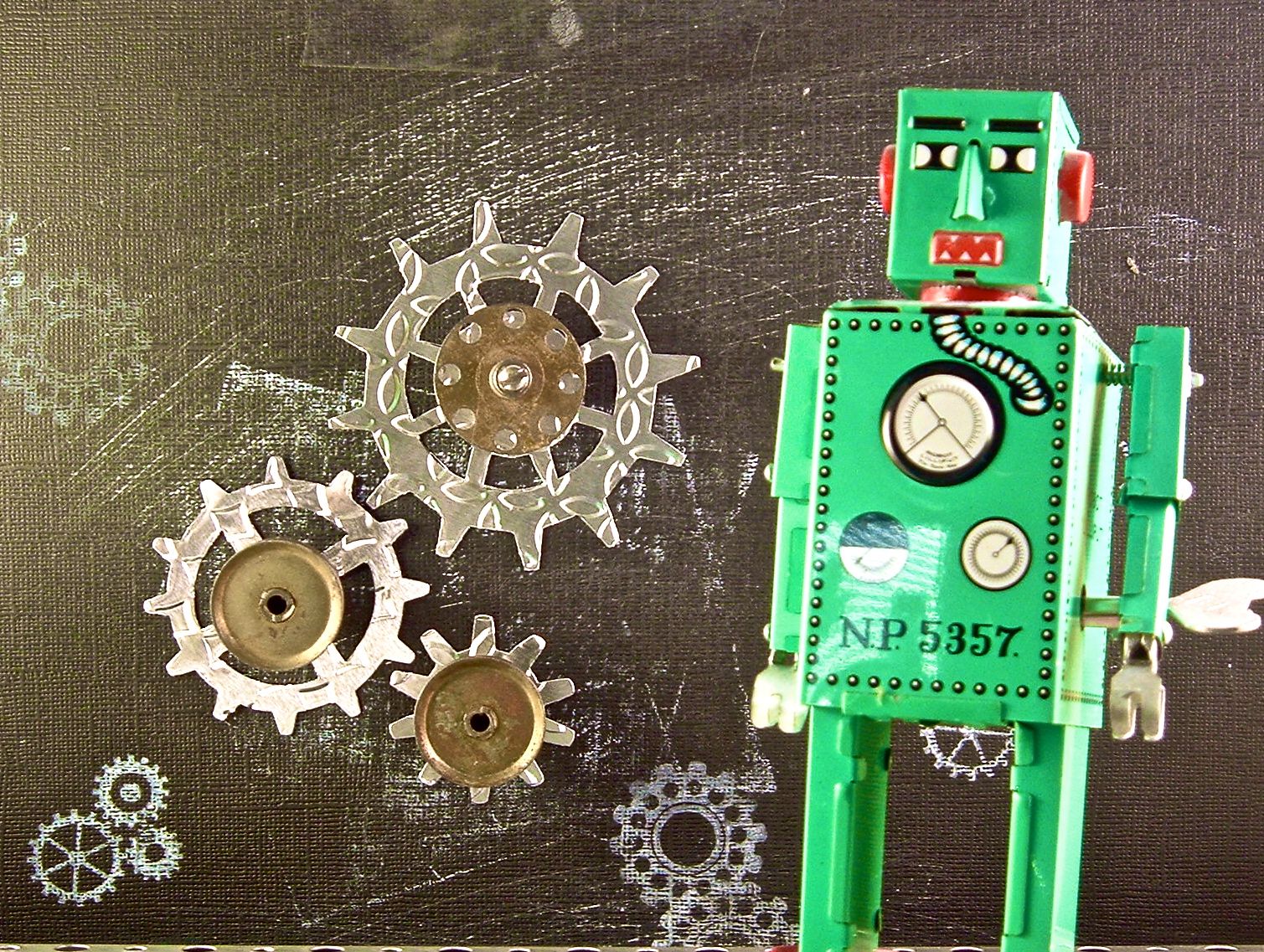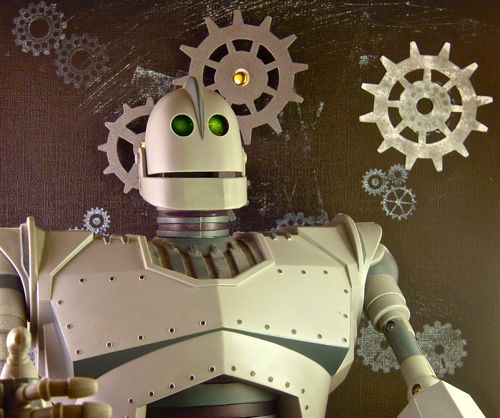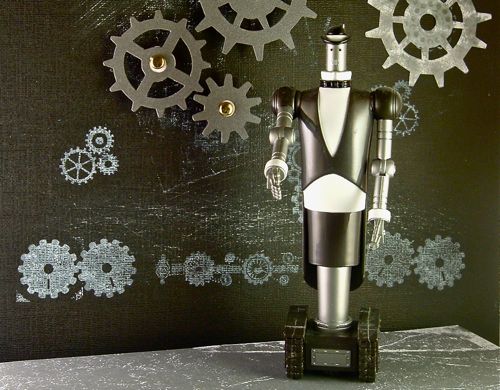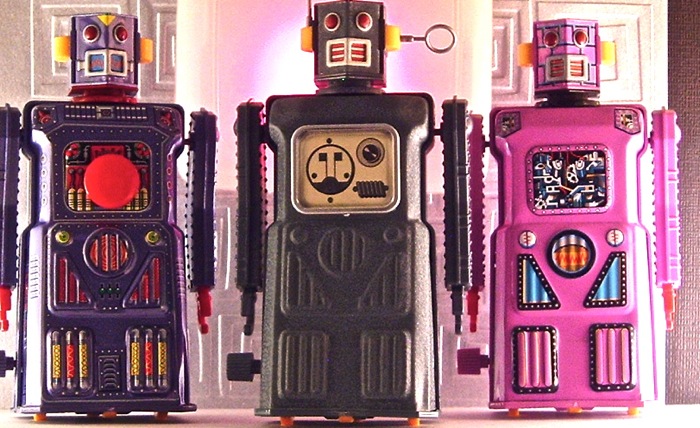Robot
Lilliput dates from the '30s.
He is thus one of the few robots not inspired by the
1956 SF film,
"Forbidden Planet", which introduced Robby, designed
by Bob Kinoshita
(who also designed Robot B-9 for "Lost in
Space"), thus
influencing robot design forever. The original
walking, wind-up
Lilliput robot was 15 cm high and orange.
Schylling's repro
editions came in large and small models, orange,
blue, and the green
variant
shown here.
Beautiful
lithography epitomized
the robot revival of the '50s. The Waco/ Marubishi
friction robot was
known, as were so many others, as simply "Robot",
distinguished by the
beautiful, imaginative art on the box cover. He
was nicknamed "Hook
Robot" for the small hook riveted to his head,
missing from this
silver/blue variant. The Yoshiya Atom Robot
was unusual for being
powered by a crank in back, which revved up a
flywheel, resulting in
the famous "bump'n'go action generally associated
with Yoshiya's
battery operated robots. The box calls him
"Friction Powered Atom Robot
with Mystery Crank Action".
Masudaya
produced some of the most
dazzling battery-powered robots of the '50s, which
featured beautiful
lithography and unique action. These
gorgeous, lithographed
tinplate robots stood 38 cm (one inch = 2.54 cm),
but were still often
named simply "Robot" on the box. Their
scarcity makes them highly
collectible. A rare model in excellent condition
has gone for as much
as $90,000 at auction. However, their real value
lies elsewhere. The
box art is still inspiring, the robot designs
still intriguing. They
still remind us of the best sense of the space
age, of looking outward
and forward, when everything seemed possible. They
still ignite our
childlike curiousity and spark our sense of
wonder.
Trendmaster's
gigantic Ultimate
Iron Giant stood 20 inches tall, but could also be
posed to sit
down. He was only available through the
Warner Bros. studio
store, as Toys R Us declined to order him for some
of all of their
stores, as they also neglected to stock the
Trendmasters Classic
Jupiter II and radio-controlled Robot B-9 from
Lost in Space.
Trendmasters sadly went out of business, and these
classic designs
instantly obtained collector stautus. The Iron
Giant shows that a great
robot can be made out of plastic. Trendmasters'
Robby the Robot dates
from the same period, and is equally collectible.
Brad
Bird's film deviates
substantially from the short kids' story, "The
Iron Giant" by Britain's
poet Laureate, Ted Hughs. The Warner Bros. film is
in one way a parable
about whether something designed for war can have
peacetime uses, a
question very much in the air in the robot eras of
the '50s and '60s.
In one way, Japan's thriving robot industry was
the key to its post-war
reconstruction, as well as helping to drive and
inspire the space age
in the US and the world. Even the name "Iron
Giant" sounds retro and
his design, although ostensibly from space,
somewhat echoes the
mechanical ages in the UK and US.
Pneuma
is Tom Strong's butler in a
comic book series created by writer
Alan Moore and artist Chris Sprouse published by
America's Best Comics,
an imprint of DC Comics. Of all the
characters depicted here, he
looks most at home with a background of mechanical
gears. Pneuma is the
root word of pneumatic, and Tom's robot butler is
steam-powered, an
idea explored in the Steampunk genre.
Numerous
examples come to mind of
how imaginative artists and designers
brought into being the best styles and designs of
their day to create
innovative and imaginative robot designs. A
treasure trove could still
be created from the endlessly-inspiring worlds of
Tom Swift, Tom
Corbett, Dan Dare, and the legion of heroes and
explorers of the
spaceways (for more robot history see books in the
Robot Store).


